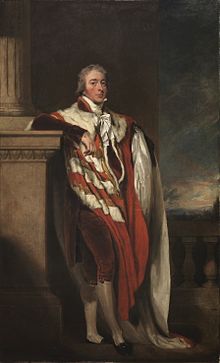John Fane, 10th Earl of Westmorland, KG, PC (1 June 1759 – 15 December 1841), styled Lord Burghersh between 1771 and 1774, was a British Tory politician of the late 18th and early 19th centuries, who served in most of the cabinets of the period, primarily as Lord Privy Seal ultimately spending 33 years in office.
The Earl of Westmorland | |
|---|---|
 Lord Westmorland in the parliamentary robes of an earl, by Thomas Lawrence c. 1806. | |
| Lord Lieutenant of Ireland | |
| In office 1789–1794 | |
| Monarch | George III |
| Prime Minister | William Pitt the Younger |
| Preceded by | The Marquess of Buckingham |
| Succeeded by | The Earl FitzWilliam |
| Lord Privy Seal | |
| In office 14 February 1798 – 5 February 1806 | |
| Monarch | George III |
| Prime Minister | Pitt, Addington |
| Preceded by | The Earl of Chatham |
| Succeeded by | The Viscount Sidmouth |
| In office 25 March 1807 – 30 April 1827 | |
| Monarchs | George III, George IV |
| Prime Minister | Portland, Perceval, Liverpool |
| Preceded by | The Lord Holland |
| Succeeded by | The Duke of Portland |
| Personal details | |
| Born | 1 June 1759 |
| Died | 15 December 1841 (aged 82) |
| Nationality | British |
| Political party | Tory |
| Spouses |
|
| Children | 10 |
| Parents |
|
Background
editWestmorland was the son of John Fane, 9th Earl of Westmorland, and Lady Augusta Bertie, daughter of Capt. Lord Montagu Bertie. He succeeded in the earldom on the death of his father in 1774.[1]
Political career
editIn 1789 Westmorland was appointed Joint Postmaster General by William Pitt the Younger[1] and sworn of the Privy Council.[2] Already the same year he was appointed Lord Lieutenant of Ireland by Pitt, a post he held until 1794. On 18 February 1793, he was appointed a deputy lieutenant of Northamptonshire.[3] From 1795 to 1798 he was Master of the Horse under Pitt. The latter year Pitt made him Lord Privy Seal, a position he would hold under five prime Ministers (Pitt, Addington, Pitt again, Portland, Perceval and Liverpool) for the next 35 years, except between 1806 and 1807 when Lord Grenville was in office.[1]
Westmorland raised a Northamptonshire volunteer cavalry regiment in 1797, and was appointed its colonel on 20 April 1797.[4] He was later Lord Lieutenant of Northamptonshire between 1828 and 1841.[1] He was made a Knight of the Garter in 1793.[5]
Family
editLord Westmorland married Sarah Anne Child (28 August 1764 – 9 November 1793), the only daughter and heiress of wealthy banker, Robert Child, against her father's wishes, at Gretna Green on 20 May 1782.[1] Child consequently cut his daughter and her sons and their descendants out of his will, and made his daughter's daughters his heirs to prevent the Fanes from benefitting from this elopement. Their eldest daughter, Lady Sarah Sophia Fane (1785–1867), having thus been made testamentary heiress of her maternal grandfather, married George Child-Villiers, 5th Earl of Jersey, her husband assuming the additional surname of Child. [citation needed]
The Earl and Countess of Westmorland had one son and four daughters:
- John Fane, 11th Earl of Westmorland (3 February 1784 – 16 October 1859),[6] who succeeded his father.
- Lady Sarah Sophia Fane (4 March 1785 – 26 January 1867) who married in 1804 George Child Villiers, 5th Earl of Jersey and became heiress to the Child fortune.
- Lady Augusta Fane (1786–1871), who married firstly in 1804 (divorced 1809) Lord Boringdon, later Earl of Morley (by whom she was the mother of Henry Villiers Parker), and in 1809 Arthur Paget (1771–1840), a younger brother of Henry Paget, 1st Marquess of Anglesey.
- Lady Maria Fane (1787–1834) who in 1805 married Viscount Duncannon, later 4th Earl of Bessborough; their sixth son Spencer Ponsonby-Fane inherited Brympton d'Evercy from his half-aunt Lady Georgiana.
- Lady Charlotte Fane (1793–1822), died unmarried.
The Countess of Westmorland died relatively young in 1793, aged only 29, from undisclosed causes. Lord Westmorland married secondly Jane, daughter of Richard Huck-Saunders, in 1800.[1] After some years of marriage, they later separated and she lived at Brympton d'Evercy. [citation needed] By his second wife, he had three sons and two daughters, of whom only the eldest child Lady Georgiana Fane outlived both parents and inherited the Brympton estate.
- Lady Cecily Jane Georgiana Fane (25 January 1801 – 1875), died unmarried, leaving Brympton d'Evercy to her nephew Spencer Ponsonby-Fane
- Hon. Charles Saunders John Fane (1802–1810)
- Hon. Col. Henry Sutton Fane (1804–1857), died unmarried.
- Hon. Montagu Augustus Villiers Fane (1805–1857), died unmarried.
- Lady Evelina Fane (1807–1808)
Lord Westmorland died in December 1841, aged 82, and was succeeded in the earldom by his only son from his first marriage, John. The Countess of Westmorland died in March 1857.[1]
Arms
editReferences
edit- ^ a b c d e f g thepeerage.com John Fane, 10th Earl of Westmorland
- ^ "No. 13140". The London Gazette. 13 October 1789. p. 653.
- ^ "No. 13708". The London Gazette. 27 September 1794. p. 987.
- ^ "No. 14012". The London Gazette. 23 May 1797. p. 472.
- ^ "No. 13537". The London Gazette. 11 June 1793. p. 490.
- ^ The Register of Births and Baptisms in the Parish of St James within the Liberty of Westminster. 1761-1786. 9 March 1784.